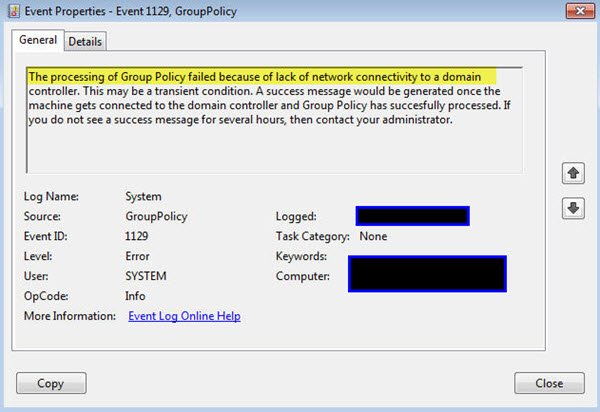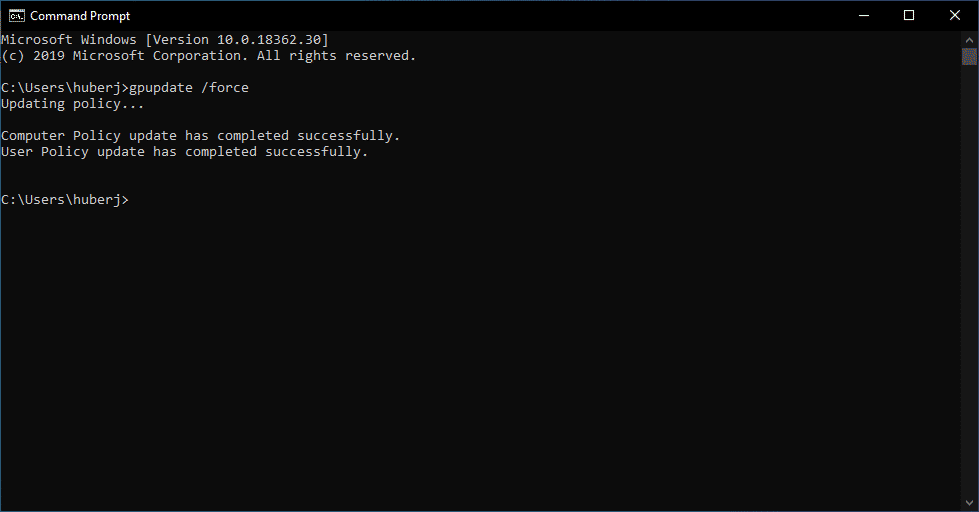Gpupdate Force
After changing any Group Policy setting using the local GPO editor (gpedit.msc) or domain policy editor (gpmc.msc), the new policy setting is not immediately applied to the user/computer. You can wait for automatic updating of GPO (up to 90 minutes), or you can update and apply policies manually using the GPUpdate command. The GPUpdate command is used to force the update of the computer and/or user group policy settings.
- Gpupdate Force Batch File Converter; Script To Run Gpupdate Force. And remember to use an extra% for all those variables if this is in a batch file. Thanks to Microsoft for making scripting a chore. Sep 11, 2013 Hi, My issue is that from command prompt (cmd) when I run the command gpupdate /force on my server 2012 it tells me that the command.
- Gpupdate command is used to update Group policies in Windows operating system Domain. There are different options to use with the gpupdate but one of the most used option is /force which will reapply all policy settings. Even “gpupdate” command provides very basic features we may need to get some help about the options.
- Gpupdate.exe was first released for Windows Vista Operating System on with Windows Vista. The latest version update v10.0.15063.0 (WinBuild.1) for Windows was 10 released on. Gpupdate.exe is included with Windows 10, Windows 8.1, and Windows 8.
Note. The secedit/refreshpolicy command was used in Windows 2000 to manually refresh group policies. In the following versions of Windows, it was replaced by the GPUpdate utility.
Step 2) Run gpupdate /force. Within the Command Line window, type gpupdate /force and then press Enter on your keyboard. The line 'Updating Policy.' Should appear in the Command Line window below where you just typed. Step 3) Restart Your Computer.
The full syntax of the gpupdate tools looks like this:
When you run the gpupdate command without parameters, only new and changed user and computer policy settings are applied.
Updating policy…
Computer Policy update has completed successfully.
User Policy update has completed successfully.

You can only update user or computer policies using the /target option. For example,
- gpudate /target:user
- gpupdate /target:computer
To enforce the update of group policy settings you can use the GPUpdate /force command.
What is the Difference Between GPUpdate and GPUpdate /force?
The gpupdate command applies only changed policies, and the GPUpdate /force command reapplies all client policies—both new and old (regardless of whether they have been changed).
READ ALSOPowerShell Function Parameters: How to Add?In most cases, you need to use gpupdate to update the policies on the computer. In large Active Directory domains, frequent use of the /force switch when updating GPOs places a heavy load on domain controllers (because computers re-request all policies targeted at them or users).
As we said earlier, group policies are updated automatically every 90 minutes or during computer startup. Therefore, in most cases you shouldn‘t use the gpupdate /force command (especially in various scenarios) due to the high load on client computers and domain controllers.
You can add a delay (up to 600 seconds) before updating policies using the /wait parameter:

Because some user policies cannot be updated in the background, but only at a user logon (installation of programs, folder redirection, etc.), you can log off for the current user with the command:
Some computer policy settings can only be applied at startup, so you can initiate a computer reboot using the /Boot parameter:
The /Sync parameter specifies that the next policy application should be performed synchronously. Active policy enforcement occurs when a computer is restarted or when a user logs on.
Invoke-GPUpdate cmdlet has been added to PowerShell 3.0, which can be used to update policies on remote computers. For example, the following command will launch a remote group policy update of on the computer PC1:
You can force policy updates on all computers in the specified
Gpupdate Force Windows 10
Introduction
I needed to script a gpupdate /force and target a group of machines in an OU. The reason I wanted to script this is because I wanted to run the force in real time and also wanted to be sure that it ran successfully on the target machines. This seemed like the best idea and seemed a better option than waiting for the policy to update and hoping it applied the updated policy registry on all systems and worse yet, needing to run reports and troll through the results.
Over the last several years, I have been lucky enough to not rely on Group Policy all that much. With tools like RES ONE and AppSense at my disposal and the fact I have been pretty application focused, Group Policy has been last resort in most environments.
Imagine my delight when I realized I didn’t need to script this!! I found a helpful article and thought I found the holy grail. An option within the Group Policy Management Console within Server 2012 that not only can force the update but also return the results! Eureka!!
In this post I will go through how to remotely execute gpupdate on all systems in an OU using Group Policy Management but importantly, in my conclusion, I will detail why you should use caution when leveraging this feature!
Run Gpupdate Force Wait
How to Force GPUpdate on an OU from Group Policy Management Console
On Server 2012 or with newer versions of RSAT on your desktop, open Group Policy Management
Browse to the OU which you would like to force the gpupdate for, right click and click on Group Policy Update…
If you are deploying to one or two machines, you’ll just receive a confirmation message. When deploying to several machines you will receiving a warning about possibly straining network resources. If you are daring enough to proceed, click Yes. (I wouldn’t be worried about running it for a few hundred machines but again, check my conclusion at the bottom of this post before proceeding)
As the update runs on the machines, the results will populate. If you get any failures, you will want to investigate on that failed machine.
Gpupdate Force Specific Domain Controller
Conclusion
But Yarrrrrr….let this be a cautionary tale…and also a brain dump for myself to serve as a reminder to never ever do this on machines in a production environment! I got pretty lucky, I ran this against some systems in a non-production environment.
On machines that got the update, the gpupdate ran interactive so the users on the machines at the time saw this prompt which could look like an issue. It’s not in this instance, my updated policy did successfully take hold but the fact this didn’t run silently makes the feature pretty useless for my future use and I would suggest that you only use it in your own home lab or sandbox environment.
Gpupdate Force Remote Computer

If you would like to ensure that the gpupdate run silently, you could change to refresh interval or script this using vbscript, PowerShell and even use PSEXEC.
I think this feature could be pretty useful, if you could be assured the update would run silently on the endpoints. Of course, in most situations you can likely just wait for the refresh interval but sometimes you may want an update to run before you can progress your work. What do you think? If you agree, please up vote this feature request on UserVoice here: User Voice for Group Policy Update Feature in Server 2016.
Get the App-V Decison Matrix and Interactive Tool.
